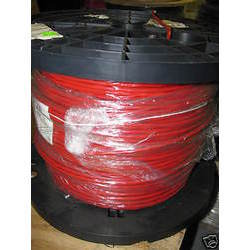
An electrical circuit’s survivability in harsh conditions is defined by the method of its installation. Some circuits that are relied upon to supply power to critical functions related to life safety need extra protection from fire, water and physical damage. Those of us in the fire alarm industry know circuit integrity (CI) cable enhances survivability from attack by fire, but where are they required and what other methods can be used?
Which Buildings Need Additional Survivability?
In facilities that don’t use general evacuation (e.g. high rises, hospitals, detention facilities), occupants may need to shelter in place for a period of time. Therefore, notification circuits are relied upon to be operable for a longer period of time. Most, if not all of these occupancies will use a voice based notification method so occupants can be given real time information and guidance by the fire department. These buildings will also have separate 2 hour rated smoke resistant zones that people can shelter in. These zones can be an entire floor (high rises) or sections of a floor (hospitals). The audio/visual circuits that serve these zones must be survivable from attack by fire for 2 hours until they reach their zone.
When Is Enhanced Survivability Not Required?
In fire alarm installations, initiating circuits (smoke detectors, pull stations, etc.) don’t need to be survivable from attack by fire. Once the fire alarm is activated, they’re no longer required. It’s helpful to know where & when subsequent alarms are occurring, but not essential. In most applications, once initiated, a fire alarm system’s notification appliances are operating and the fire department is on the way. Additionally, if the building notification is a general alarm for immediate & complete evacuation, fire alarm circuit survivability does not need to be enhanced.
High Rises
High rises use selective or private mode signaling to prevent too many people from trying use stairwells at the same time. Fire alarm systems in high rises generally use electrical rooms as riser or equipment spaces since they’re constructed to provide 2 hour protection from fire. If these rooms are stacked from floor to floor, 2 hour rated cabling is not needed for individual notification circuits.
Class A Risers
Class A return risers are usually run in egress stairwells that are 2 hour rated, so additional protection isn’t needed there. However, once the return riser leaves the stairwell to return back to the originating panel, the notification circuits in that riser must utilize 2 hour rated cabling until it reaches the room housing the source. Please note: the activation of notification circuits is usually dependent on inter-panel network communications. Any portion of this networking cable (including separate network audio risers) installed outside of a two hour enclosure must utilize circuit integrity (CI) or mineral insulated (MI) cabling until it reaches a 2 hour enclosure.
Hospitals
Hospitals generally use private mode signaling since many of its occupants cannot leave the building on their own. This type of notification method is intended solely for responding staff and there is no immediate evacuation. Hospitals are therefore required to be compartmentalized into smoke zones where people can shelter until relocated or evacuated. Hospital notification circuits are mostly horizontal & must be 2 hour rated until they reach the smoke zone they serve, which is why they usually only serve a single smoke zone. Otherwise they’d have to stay 2 hour rated until they reach the last smoke zone.
There are other instances in which 2 hour rated pathways must be installed for a fire alarm and other systems. Affiliated Fire Systems has 38 years of knowledge & experience, plus state-of-the-art Gamewell-FCI equipment to ensure your project is code compliant before it starts. Contact us to get more information.
Gene Rowe NICET Level IV, Fire Alarm Systems Affiliated Fire Systems, Inc. Downers Grove, IL


In a multistory hospital with partial evacuation (by floor), if a fire alarm circuit leaves the control panel and goes through one smoke compartment to get to another, is CI cable required until the circuit gets to the smoke compartment it feeds? I know I’ve run across this before, but I seem to be having a hard time finding these requirements in the code books again.
Hi Eddie,
Per the hospital’s written fire response plan, if smoke zones are not used to re-locate occupants from a zone in alarm on that same floor, then NFPA 72 Chapter 23.10.2 allows the NAC circuits serving that floor to be converted back to non-CI once they reach the floor. NFPA 72 Chapter 23.10.2 states: “Fire alarm systems used for partial evacuation and relocation shall be designed and installed so that attack by fire within a notification zone shall not impair control and operation of the notification appliances outside that notification zone.”
Therefore, if the NAC circuits originate on that floor, you wouldn’t need CI for the NAC circuits since the whole floor is the evacuation zone. However, if the method of triggering the NAC panel originates from a different floor, then the circuit that controls the trigger would need to be installed with 2 hour survivability. For example, if you’re using an addressable module to trigger & monitor the NAC panel, the SLC must also originate from the same floor or else it would have to be run in CI before it gets to the floor. You know that ain’t happening, so if you’re using that method, make sure your SLC starts on the floor or is dedicated to the floor & is in CI until it gets to the floor to avoid violating NFPA 72. Remote data gathering panels per floor work well since they can operate in stand alone mode if you lose network communications.
I hope I answered your question satisfactorily. Feel free to contact me if you have any questions and don’t forget Gamewell-FCI fire alarm equipment can accommodate fiber, CI, THHN conductors.
Gene Rowe, SET
NICET Level IV, Fire Alarm Systems
Affiliated Fire Systems, Inc.
Downers Grove, IL